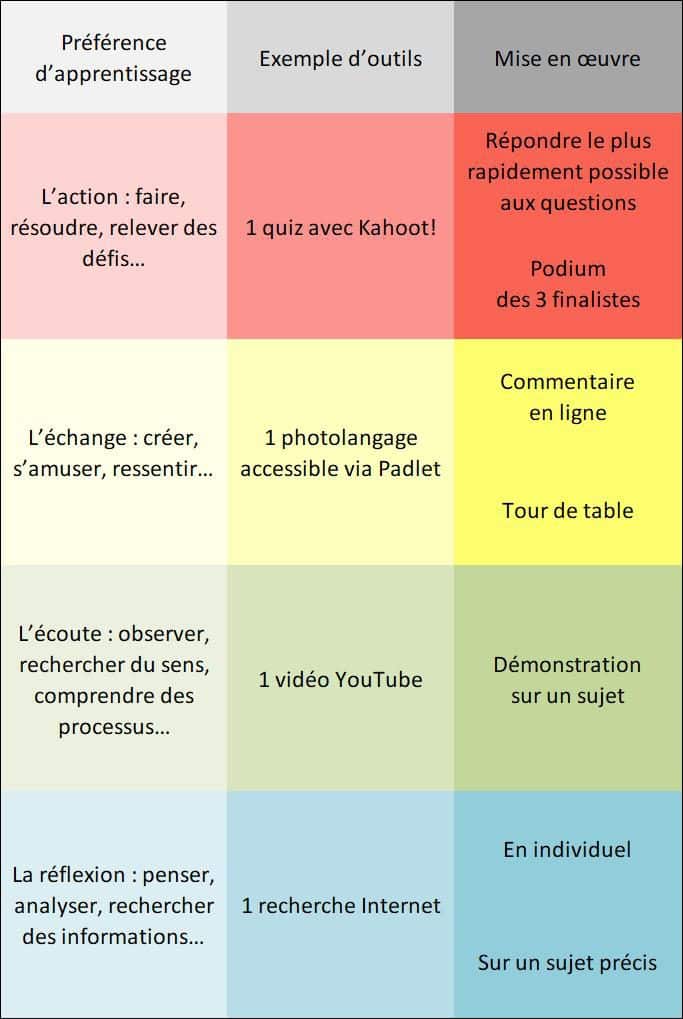Digital tools are an essential part of distance learning, but they also have a number of advantages that can be transferred to face-to-face training. Each tool has its own pedagogical purpose. How are they chosen? How are they used? An overview of best practice.

Adapting thanks to digital tools. In 2020, they enabled the world of training to adapt to the COVID-19 context and to new expectations in terms of distance learning. The idea is to retain the dynamics of face-to-face training in a distance learning format. Online digital tools have encouraged exchanges, captured the attention of participants and made them active... In 2022, these are all assets that legitimise their use in face-to-face training. So how do trainers select the most appropriate digital tools? And when should they be used during face-to-face training? Marine Gandouet, coach and trainer, takes a closer look.
What role can digital tools play in face-to-face sessions?
First of all, it is important to bear in mind that the digital tools used in distance learning are at the service of learning. In other words, they serve the specific needs and interests of the participants. The key idea is that their many advantages are equally effective in face-to-face situations.
6 good reasons for integrating digital tools into face-to-face training courses
- Diversifying learning
With digital tools, trainers can set the pace. It also allows them to approach concepts in a fun way. In this way, participants are more easily receptive.
- Creating positive emotions
Whether through their form - the tool itself - or their content (a video, for example), some digital tools can make you smile or even laugh. As the brain seeks pleasure and avoids boredom, learning will be that much easier.
- Surprise, arouse interest and curiosity
A day's training might seem like a long time... but that's not at all the case if you come along and surprise the participants. Why not use a GIF related to the subject being covered, an offbeat video with a humorous tone, or even a photolangage shared with the Padlet tool, from which participants can comment directly using their smartphone. The aim is to get them excited about learning!
- Making it easier to remember
To learn better, the brain needs repetition. And digital tools can help!
- Promoting team cohesionteam
The group itself is a strength in training. Feeling at ease with others, being listened to and free to express yourself or ask questions: these are all ingredients for a successful training course. Used properly, digital tools create and reinforce group cohesion.
- Clarifying and structuring training
Certain tools provide clarity and structure to training. They incorporate a large number of resources and enable the training programme to be approached according to a well-defined schedule.
How do you choose the right digital tools?
The major risk of digital tools is losing the link with participants. In other words, losing their attention. Either because there are too many tools. Or because they don't know how to use the tool. Using too many tools or the wrong tool can also make learning more complex. That's why the trainer doesn't choose them at random, but to achieve a specific objective.
Which tool for which educational purpose?
| Educational aims | Examples of digital tools |
|---|---|
| Preparing for training in advance | Google Forms Forms DragnSurvey |
| Structuring training and encouraging follow-up | Padlet to display the complete lesson plan |
| Energising the group | Genially to create a serious game Wordwall with the random wheel: visual and sound effects guaranteed! |
| Introduce a subject (arouse curiosity, take the temperature of participants' knowledge) | YouTube to watch a video Edpuzzle for designing a video quiz Wooclap to create a survey |
| Provide content for participants with dynamic or punchy presentations | Genially for an interactive presentation or image Prezi for an innovative presentation |
| Anchoring learning | Wooclap or Kahoot! for a quiz Hummingbird post-it notes: participants write on digital post-it notes what they remember from the sequence. |
Digital tools: how to use them effectively?
As with distance learning, the use of digital tools in face-to-face training requires a number of prerequisites on the part of the trainers. Familiarity with digital tools, of course. But also an appetite for digital technology in general. And, last but not least, an expert's eye: what makes a particular tool the most relevant to the teaching objective?
As far as the participants are concerned, their level of interest in digital technology and their comfort with its tools are also essential factors. That's what pre-training questionnaires are all about. For example pre-requisite test of the Klaxoon training. Feedback from participants also guides trainers in selecting the best tools.
Varying approaches according to learning preferences
The digital tools used in face-to-face training remain at the service of learning. That's why using them effectively means identifying the learning preferences of participants.
4 learning preferences

The idea is to use digital tools to alternate the pace of learning throughout the day. In this way, each participant will benefit from training sequences adapted to his or her learning preferences.
Ultimately, the use of digital tools in training cannot be improvised. It's up to the trainer to prepare what seems most appropriate, bearing in mind that each tool has a specific purpose. Creating positive emotions, using games or even soliciting the participation of a group of people can all be useful tools. creativity enables complex subjects to be tackled, or subjects that may give rise to reluctance to change. These are just some of the advantages offered by digital tools, whether for distance learning or face-to-face training.


